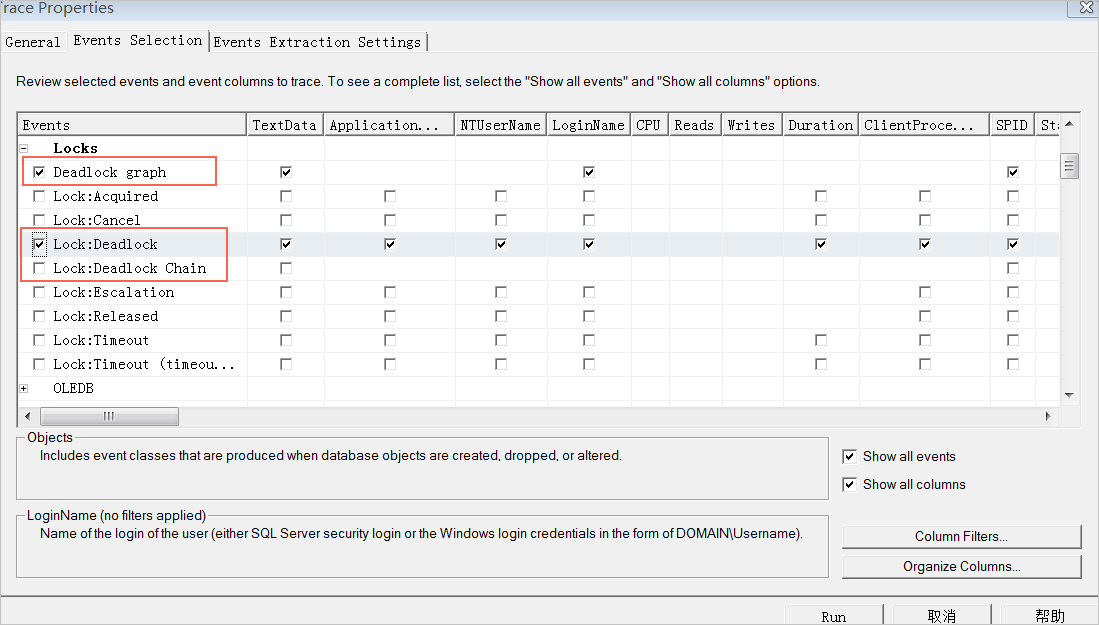Problem description
When an application frequently reads or writes a table or resource, it is prone to deadlock. In case of a deadlock, SQL Server chooses to terminate one of the transactions and sends the following error message to the client that initiated the transaction.
Error Message:Msg 1205, Level 13, State 47, Line 1Transaction (Process ID 53) was deadlocked on lock resources with another process and has been chosen as the deadlock victim. Rerun the transaction.Solution
Use a client to connect to an instance. For more information, see connect instances.
Monitoring views.
Run the following SQL statement to periodically monitor sys.sysprocesses.
while 1=1 begin select * from sys.sysprocesses where blocked<>0 waitfor delay '[$Time]' endNoteThe [$Time] loop gap can be customized, for example, 00:00:01.
The following command output is returned.
 Note
Notein the monitoring result, the value of the blocked column is the ID of the blocked Source session, and the waitresource is the resource that the blocked session is waiting for. As can be seen from the above results, spid 53 and spid 56 are blocking each other, forming a deadlock.
Run the following SQL statement to periodically monitor views such as sys.dm_tran_locks and sys.dm_os_waiting_tasks.
while 1=1 Begin SELECT db.name DBName, tl.request_session_id, wt.blocking_session_id, OBJECT_NAME(p.OBJECT_ID) BlockedObjectName, tl.resource_type, h1.TEXT AS RequestingText, h2.TEXT AS BlockingText, tl.request_mode FROM sys.dm_tran_locks AS tl INNER JOIN sys.databases db ON db.database_id = tl.resource_database_id INNER JOIN sys.dm_os_waiting_tasks AS wt ON tl.lock_owner_address = wt.resource_address INNER JOIN sys.partitions AS p ON p.hobt_id = tl.resource_associated_entity_id INNER JOIN sys.dm_exec_connections ec1 ON ec1.session_id = tl.request_session_id INNER JOIN sys.dm_exec_connections ec2 ON ec2.session_id = wt.blocking_session_id CROSS APPLY sys.dm_exec_sql_text(ec1.most_recent_sql_handle) AS h1 CROSS APPLY sys.dm_exec_sql_text(ec2.most_recent_sql_handle) AS h2 waitfor delay '[$Time]' EndThe following command output is returned.

 Note
NoteDBName:request_session_id database.
request_session_id: the ID of the blocked session.
blocking_session_id: the ID of the blocked Source session.
BlockedObjectName: the object of blocked session operations.
resource_type: the type of resources to wait for.
RequestingText: the statement that has been executed for the current session.
BlockingText: the statement that blocks the source session.
request_mode: the lock mode requested by the current session.
If you use RDS SQL Server 2012, you can use SQL Server Profiler to monitor and capture the deadlock graph, as shown in the following figure.
 The following figure shows the deadlock graph.
The following figure shows the deadlock graph. 
Perform optimization based on the actual situation.
Close the blocked Source session to help quickly remove the blocking.
Check whether there are transactions that have not been submitted for a long time, and submit the transactions in time.
Use with(nolock) for query.
NoteIf an S lock is involved in the deadlock and the application allows dirty reading, you can use the with(nolock) command to avoid requesting a lock by the query statement, thus avoiding the deadlock, as shown in the following SQL statement.
select * from table with(nolock)Check the application logic and access a resource in sequence.
Application scope
ApsaraDB RDS for SQL Server